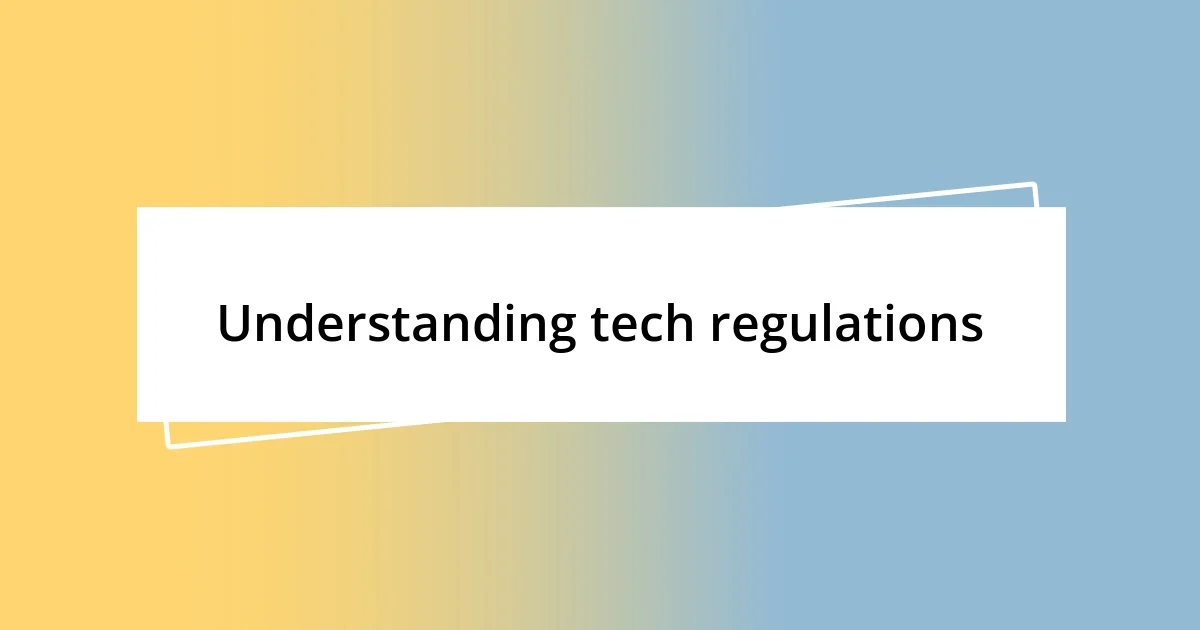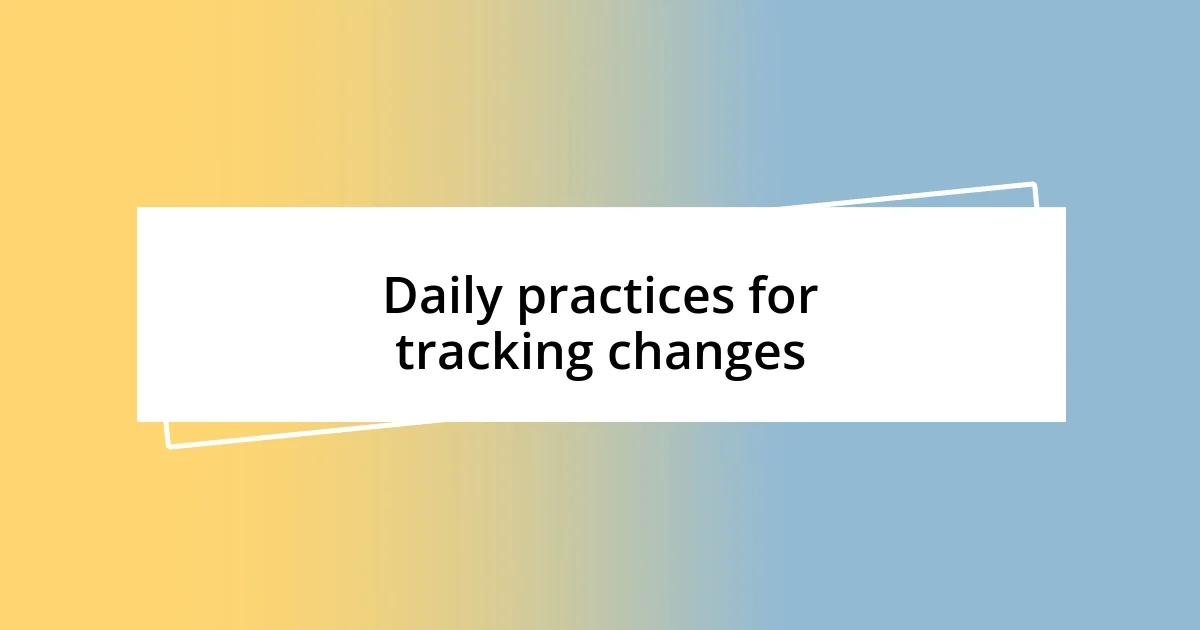Key takeaways:
- Understanding tech regulations, such as GDPR and CCPA, empowers individuals to protect their personal data and fosters a healthier tech environment.
- Utilizing various sources, including government sites, industry news, and professional associations, enhances knowledge and keeps individuals informed about evolving regulations.
- Implementing daily practices like compliance checklists and team knowledge sharing promotes accountability, clarity, and collaboration in navigating complex regulatory landscapes.

Understanding tech regulations
Tech regulations might seem like a maze, but I’ve found that understanding them can feel incredibly empowering. The ever-evolving landscape of laws, such as those governing data privacy and cybersecurity, reminds me of when I first navigated GDPR—a real head-scratcher at the time. Can you remember a moment when you felt overwhelmed by intricate rules? It’s that initial confusion that makes the “aha” moment so rewarding.
As I dove deeper into tech regulations, I realized they serve a crucial purpose: they protect users like you and me. For instance, when I learned about the California Consumer Privacy Act (CCPA), it clicked for me just how vital it is to know my rights regarding personal data. It’s a bit like standing guard over your own information, don’t you think?
Moreover, the interplay between innovation and regulation fascinates me. Regulations can feel restrictive, but they often lead to healthier tech environments and foster trust. When I’ve shared my insights with my peers, I’ve noticed a shared realization: understanding these rules isn’t just about compliance; it’s about creating a tech space where we can thrive together. How do you feel about the balance between regulation and innovation? It’s a conversation worth having.

Key sources for tech regulations
When it comes to tracking tech regulations, I rely heavily on a few key sources that consistently keep me informed. For instance, I subscribe to newsletters from tech law firms and regulatory bodies. It’s fascinating how these experts break down complex topics into digestible insights that make my learning journey smoother. I also engage with online communities where professionals share their experiences and interpretations, which adds a richer layer to my understanding.
Here are some essential sources that I recommend:
- Government Websites: Stay up-to-date directly from the source, like the Federal Trade Commission (FTC) or your country’s equivalent.
- Industry News Outlets: Platforms such as TechCrunch or Wired frequently cover regulatory updates and their implications.
- Legal Blogs and Newsletters: Websites like Lexology provide excellent analyses of new rulings and regulations tailored for tech professionals.
- Webinars and Conferences: Attending these events helps me network with experts and hear real-time discussions about the evolving landscape.
- Social Media: Following thought leaders on Twitter or LinkedIn often leads me to valuable insights and resources.
I remember attending a webinar last year where a privacy law expert shared their take on the shift in regulations due to technological advancements. It was so eye-opening! Their interpretation made me appreciate different viewpoints on policy change and how these regulations can adapt to new realities. Conversations like that stick with me long after the event, shaping my understanding and approach to compliance.

Daily practices for tracking changes
Keeping up with tech regulations is a daily practice that I find both enlightening and essential. One method I employ is setting aside time each morning to browse through curated lists of regulatory news. This habit started during a particularly busy regulatory season when I realized that missing a single update could mean being blindsided by compliance issues. I remember one day stumbling upon a significant change in data protection laws just in time to adjust my project compliance strategies. The relief I felt from being proactive instead of reactive still motivates me.
Another practice I incorporate is using digital tools to manage and track updates. For instance, I utilize monitoring software that alerts me to significant regulatory developments. The first time I set up alerts for specific keywords, it transformed my workflow. Instead of sifting through countless articles, I now receive tailored updates. That moment of discovery—when technology simplified my information gathering—felt like I had a personal assistant solely focused on keeping me compliant!
Lastly, I’m a big advocate for sharing knowledge with colleagues. Weekly huddles have become instrumental for my team and me to exchange insights on regulations we’ve each encountered. Just last week, a coworker shared a resource that clarified some confusing compliance guidelines, and it sparked a great discussion! These exchanges not only enrich our understanding but also build a supportive community around navigating the regulatory landscape together.
| Practice | Description |
|---|---|
| Daily News Review | Setting aside time each morning to browse regulatory updates. |
| Monitoring Software | Utilizing alerts for updates on important regulatory keywords. |
| Team Knowledge Sharing | Weekly meetings to exchange insights and resources among colleagues. |

Utilizing tech regulation tools
When it comes to utilizing tech regulation tools, I’ve found that the right digital resources can make a world of difference. One tool I love is a regulatory compliance dashboard. I remember diving into one for the first time—it was like flipping a switch! The way it allows me to visualize compliance status across different areas is incredibly powerful. It saves me from being buried in paperwork and provides instant clarity on where I stand, making compliance feel much less daunting.
I also use collaborative platforms to streamline communication with my team. For instance, employing tools like Slack or Microsoft Teams helps us share insights on tech regulations efficiently. Just last month, my colleague posted a quick update about a new data privacy rule, and within minutes, we had a discussion going that really fleshed out its implications. Doesn’t it feel great when teamwork transforms a complex topic into something manageable? These platforms foster an environment of continuous learning that keeps us all informed and agile.
Finally, I can’t stress enough how beneficial it is to integrate technology into my workflow for tracking these regulations. There’s a specific app I downloaded that pulls in global regulatory news by industry—talk about a game changer! I remember being overwhelmed trying to sift through downloads from various sites, but this tool now gives me customized news feeds based on my interests. How efficient is that? It’s like having my own regulation assistant working round-the-clock to ensure I never miss important updates.

Joining professional tech associations
Joining professional tech associations has been a game-changer for me. I remember my first encounter with one—it was at a local chapter meeting, and the energy in the room was palpable. I was surprised to find not only seasoned professionals but also newcomers eager to share their experiences and insights. That sense of community immediately reassured me that I wasn’t navigating the complex world of tech regulations alone.
I’ve found that these associations offer access to a wealth of resources—webinars, articles, and networking events. Just last month, I attended a conference organized by my tech association that illuminated some emerging legal trends in our field. The exchange of ideas during those sessions sparked several new initiatives in my work. Isn’t it fascinating how a simple conversation can lead to innovative solutions? Engaging with experts and peers who are equally passionate makes staying current so much easier.
The relationships I’ve built through these professional groups have also been incredibly rewarding. Connecting with like-minded individuals has opened doors to mentorship opportunities, helping me navigate challenging regulatory landscapes. Reflecting on my journey, I can confidently say that those connections have not only offered guidance but also fostered a sense of accountability. When you’re part of a community striving for excellence, it naturally pushes you to elevate your own standards. I often wonder how many people are missing out on this collaborative spirit—could joining a tech association be the missing link in their professional journey?

Participating in relevant webinars
Participating in relevant webinars has truly enriched my understanding of tech regulations. I can still recall attending my first webinar on data protection—sitting in my home office, I felt the excitement build as the speaker outlined intricate regulatory challenges. I was amazed at how engaging a virtual format could be, and by the time it wrapped up, I was brimming with questions and fresh ideas. Isn’t it fascinating how digital platforms can offer such meaningful insights right from our screens?
These sessions are more than just lectures; they’re vibrant discussions packed with diverse perspectives. After one particularly eye-opening webinar, I reached out to a fellow participant on LinkedIn, and we ended up collaborating on a project. It’s incredible how a shared interest can lead to unexpected opportunities. The dynamic use of polls and Q&As during webinars, I’ve found, encourages interaction that feels almost like an engaging classroom environment. Can you imagine gaining fresh insights while having your pressing questions addressed in real-time?
I also appreciate how webinars often feature industry leaders sharing real-world experiences. It was during a session with a compliance officer from a major tech company that I learned about their innovative strategies for handling regulatory shifts. That particular insight inspired me to rethink our own approach to compliance. Participating in these discussions not only keeps me informed, but they also spark a certain enthusiasm about navigating regulatory landscapes. How rewarding it is to feel like part of a larger conversation while gaining tools to tackle challenges head-on!

Implementing compliance checklists
Implementing compliance checklists has become an essential practice in my routine. I remember when I first started using them; I crafted a checklist for GDPR compliance, and it felt empowering to break down the overwhelming requirements into manageable steps. Each box I ticked off provided a sense of accomplishment and clarity, making what seemed daunting into an achievable process. Isn’t it satisfying to see tangible progress, especially in a field that can feel like an endless maze?
One of the most significant benefits I’ve found is the collaborative aspect of these checklists. After sharing my initial checklist with my team, we collectively recognized areas for improvement and necessary additions. It transformed a solitary task into a group effort, fostering a sense of ownership among us all. Have you ever noticed how collaboration can illuminate gaps you may not have seen on your own? The resulting discussions were incredibly insightful and allowed us to fine-tune our approach effectively.
Feeling a sense of accountability when using a compliance checklist is another key advantage. I often set deadlines for each section, which motivates me to stay on track. It’s funny how a simple list can help manage what feels like a whirlwind of regulations. In fact, I find that it not only aids in compliance but also nurtures a mindset of continuous improvement. What would it mean for you to have that clarity and focus while navigating an ever-changing regulatory landscape?














